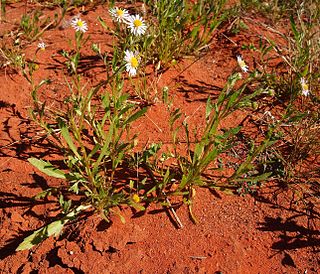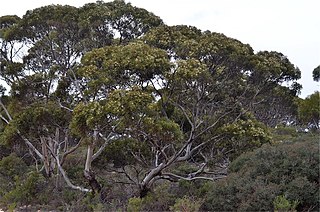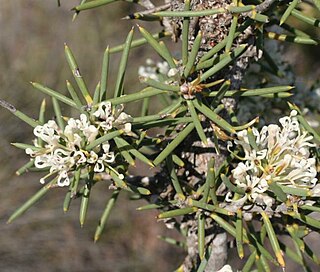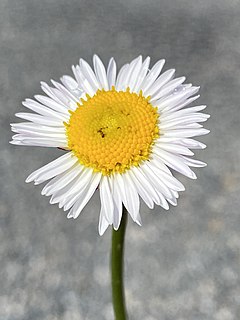
Leucanthemum vulgare, commonly known as the ox-eye daisy, oxeye daisy, dog daisy, marguerite and other common names, is a widespread flowering plant native to Europe and the temperate regions of Asia, and an introduced plant to North America, Australia and New Zealand.

Xerochrysum bracteatum, commonly known as the golden everlasting or strawflower, is a flowering plant in the family Asteraceae native to Australia. Described by Étienne Pierre Ventenat in 1803, it was known as Helichrysum bracteatum for many years before being transferred to a new genus Xerochrysum in 1990. It is an annual up to 1 m (3.3 ft) tall with green or grey leafy foliage. Golden yellow or white flower heads are produced from spring to autumn; their distinctive feature is the papery bracts that resemble petals. The species is widespread, growing in a variety of habitats across the country, from rainforest margins to deserts and subalpine areas. The golden everlasting serves as food for various larvae of lepidopterans, and adult butterflies, hoverflies, native bees, small beetles, and grasshoppers visit the flower heads.

Banksia gardneri, commonly known as prostrate banksia, is a species of prostrate shrub that is endemic to Western Australia. It has pinnatipartite or serrated leaves, usually rusty brown flowers, and up to twenty-five elliptical follicles in each fruiting head. It occurs along the west part of the south coast of the state.

Banksia erythrocephala is a species of prickly shrub that is endemic to Western Australia. It has erect stems, sharply pointed pinnatifid leaves, cream-coloured and reddish black or all cream-coloured and yellow flowers, and egg-shaped fruit.

Symphyotrichum lateriflorum is a species of flowering plant in the aster family (Asteraceae). Commonly known as calico aster, starved aster, and white woodland aster, it is native to eastern and central North America. It is a perennial and herbaceous plant that may reach heights up to 120 centimeters and widths up to 30 cm (1 ft).

Vittadinia is a genus of Australian and New Zealand plants in the aster tribe within the daisy family.

Grevillea agrifolia, the blue grevillea, is a species of flowering plant in the family Proteaceae and is native to the north of Western Australia and parts of the Northern Territory. It is a shrub or tree with narrowly oblong leaves with the narrower end towards the base, and creamy-yellow flowers.

Olearia stuartii is a shrub or subshrub species in the family Asteraceae.
Olearia asterotricha, commonly known as rough daisy-bush, is a species of flowering plant in the family Asteraceae. A tall shrub with white, mauve or blue daisy like flowers growing from the Blue Mountains in New South Wales to western Victoria, Australia.

Eucalyptus gracilis, commonly known as yorrell or white mallee, is a species of mallee or small tree endemic to Australia, where it is found in south-western New South Wales], Victoria, South Australia and Western Australia. It has smooth white bark, usually with rough, fibrous or flaky bark on the lower stems, linear to narrow lance-shaped adult leaves, flower buds in group of between seven and eleven and cup-shaped, cylindrical or barrel-shaped fruit.

Hakea psilorrhyncha is a flowering plant in the family Proteacea, it is endemic to a small area on the west coast in the Wheatbelt and Mid West regions of Western Australia. It has needle-shaped, sharply pointed leaves and clusters of scented brownish yellow flowers.

Xanthorrhoea gracilis, commonly known as the graceful grasstree, grassboy or mimidi, is a species of grasstree of the genus Xanthorrhoea native to Western Australia.
Calotis cymbacantha, the showy burr daisy, is a species of Calotis native to the arid areas of Australia. It is a perennial herb that grows between 10 and 40 cm tall. It has hairy erect stems which are woody at the base and produces yellow flowers.

Veronica gracilis is a plant belonging to the family Plantaginaceae, commonly known as slender speedwell. It is a perennial herb with slender branches, variable shaped leaves and small lilac flowers in spring and summer.

Brachyscome ascendens, the border ranges daisy, is a species of flowering plant in the family Asteraceae and is endemic to Australia. It has mostly mauve daisy-like flowers and a yellow centre.

Brachyscome nivalis, commonly known as snow daisy, is a perennial herb in the family Asteraceae and is endemic to Australia. It has mostly white daisy-like flowers, yellow centres and deeply lobed leaves.

Chrysocephalum baxteri, known by the common name fringed everlasting is a perennial herb native to southern Australia. It is a member of the Asteraceae, the daisy family. Found in low heath country and sclerophyll forest. A small plant, 10 to 40 cm high with many stems. Leaves are linear in shape, 4 to 30 mm long, 0.5 to 2.5 mm wide. Both leaf surfaces are a felty grey/green. White flowers mostly form in spring and summer.

Chrysocephalum pterochaetum, known by the common name perennial sunray is a perennial herb native to outback and desert areas of Australia. A member of the Asteraceae, the daisy family. A small plant, 15 to 40 cm high with many stems. Leaves are linear to linear oblanceolate in shape, 10 to 30 mm long, 1 to 1.5 mm wide. Leaf surfaces are rough and glandular, and may have felty white hairs. Yellow flowers mostly form throughout the year, but often seen from June to October. Originally collected in 1851 near Kanyaka, South Australia. The habitat of this plant includes sand among rocks, in or near dry creek beds, exposed rocky hill slopes and sandy gibber. The specific epithet pterochaetum is derived from the Ancient Greek language, ptero (winged) and chaetum (hair).

Vittadinia arida is an annual, herbaceous plant in the daisy family Asteraceae, found in arid, rocky areas of the Australian outback. A small plant, 10 to 30 cm tall.

Vittadinia cuneata, known by the common name fuzzweed, is a is an annual or perennial, herbaceous plant in the daisy family Asteraceae. Stems are rigid and erect with hairs. Widespread in a variety of different habitats in many parts of Australia, particularly the south east. A small woody plant, 10 to 40 cm high. Pale blue to mauve coloured flowers form in most parts of the year. The type specimen was collected in 1817 by Allan Cunningham on the banks of the Lachlan River.


















